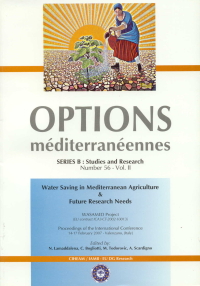| Article précédent | p. 199-205 | Article suivant |
Salmonella transport and persistence in soil and plant irrigated with artificially inoculated reclaimed water: climatic effects
Secondary effluent chlorination is extended but there are incidences in which Salmonella survive, contaminating reclaimed water ponds. Specific site conditions influence pathogens existence and persistence. The aim of the experiments was to increase the scientific information on the climatic and soil effects on pathogens transport and survive under agricultural conditions. Five pots were irrigated using a secondary effluent artificially inoculated with Salmonella. To study the effect of competence with soil bacteria, plates with sterilized soil were also tested. Radiation effect was also studied by blocking UV light. Stems and leaves, three different soil depths (surface, 0.15 and 0.45 m) and plates were sampled. As result of the radiation effect, less bacterial counts on plant were obtained during the day. But during the night, Salmonella was able to re-grow, depending on the nocturnal temperatures. After 3 weeks in the field, Salmonella was still detected in plant samples. The solar radiation caused Salmonella death in soil samples in spring while natural soil bacteria competence was the main factor affecting in autumn. Soil was able to filtrate Salmonella, but preferential flux transported bacteria to 0.45 m depth, surviving 3 weeks. Soil physical properties, irrigation system and water management will have an effect on the sanitary risk associated to reclaimed water irrigation. In this sense, subsurface drip irrigation systems (SDI) must be considered as the safest irrigation method.
L'objectif de ce travail est de contribuer à la connaissance de l'effet du climat et des sols sur le transport et la survie de la salmonelle malgré la chloration de l'eau, en conditions agricoles. Cinq pots, semés de medicago sativa ont été irrigués avec un effluent secondaire dans lequel la salmonelle a été inoculée artificiellement. Les paramètres climatiques ont été enregistrés à l'aide d'une station automatique. Les tiges et les feuilles, ainsi que trois profondeurs de sols (surface, 0.15 et 0.45 m) ont été échantillonnés. La radiation solaire a eu comme effet de réduire le nombre de bactéries le jour mais celles-ci se sont re-développées la nuit en fonction des températures nocturnes. Trois semaines après, on pouvait toujours détecter la salmonelle dans les échantillons de plantes. La radiation provoque la mort de la salmonelle dans les échantillons de sol au printemps tandis que ce sont les capacités bactériennes naturelles du sol qui entraînent sa mort en automne. Le sol était capable de filtrer la salmonelle mais à travers le flux préférentiel, elle peut atteindre le sous-sol (0.45 m de profondeur) où elle peut survivre 3 semaines. Les propriétés physiques du sol, le système d'irrigation et la gestion de l'eau auront un effet sur le risque sanitaire lorsqu'il est associé à l'utilisation d'eau non potable en irrigation. C'est pourquoi l'irrigation souterraine en goutte à goutte doit être considérée comme le système le plus sûr.
- [ Afficher ]
- [ Télécharger ]
- [ Exporter la citation ]
Vous pouvez télécharger la citation au format :
- [ Imprimer ]
-
Mots-clés
IRRIGATION, PROPRIETE PHYSICOCHIMIQUE DU SOL, RADIATION SOLAIRE, REUTILISATION DES EAUX, SALMONELLA, SURVIE, TRAITEMENT DES EAUX USEESCiter cet article
Palacios M.P., Lupiola P., Fernandez-Vera F., Mendoza V., Tejedor M.T. Salmonella transport and persistence in soil and plant irrigated with artificially inoculated reclaimed water: climatic effects. In : Lamaddalena N. (ed.), Bogliotti C. (ed.), Todorovic M. (ed.), Scardigno A. (ed.). Water saving in Mediterranean agriculture and future research needs [Vol. 2]. Bari : CIHEAM, 2007. p. 199-205. (Options Méditerranéennes : Série B. Etudes et Recherches; n. 56 Vol.II). Proceedings of the International Conference WASAMED Project (EU contract ICA3-CT-2002-10013), 2007/02/14-17, Valenzano (Italy). http://om.ciheam.org/om/pdf/b56_2/00800189.pdf



